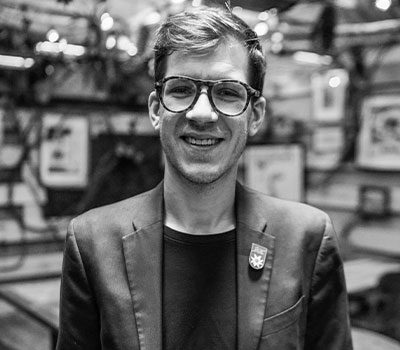

Benjamin Gutenbrunner, Blume/Hütte | NYC
Interviewed by Tara Q. Thomas
Benjamin Gutenbrunner is the creative force behind Blume and Hütte, a pair of seasonal Austrian-focused pop-ups that have taken on permanence in the back yard of Upper East Side butcher shop Schaller & Weber. Blume came first, with a vision for a “heurige/wine garden style,” which was so popular that Gutenbrunner added a ski hut (the Hütte) for the wintertime. Working with eight tables and four electric burners, Gutenbrunner offers his 230-bottle list to over 100 covers a night.
On line-pricing wine by the glass
I did it a little differently—all my wines by the glass are priced the same because I don’t want people to judge by price. People don’t know about Austrian wine. They are going to go for grüner veltliner or riesling, or the cheapest wine on the menu. So I was like, you know what, let me charge them all at $14. And then you have to pick what you want to drink instead of picking by the price.
I just feel like we—the wine world—made it a little complicated sometimes for customers and consumers. And they’re a little scared sometimes, when you say, “oh, I’ll bring the sommelier over” they’re like, “No, no, no, it’s fine; I’ll order from you,” because they just feel like they can’t say, “Oh, I didn’t like that wine.” Or the guy’s going to tell you a story. I have a casual approach to the whole thing. If you don’t like a wine, I can see it on your face, and if you don’t like that one, I’ll take it back.
How many people are familiar with Austrian wines?
Not a lot. Grüner and riesling. That’s about it. And riesling—they think it’s German riesling. They’re always surprised. They’re like, “Oh, it’s not full of sugar.” I’m like, “Yeah, it’s not.”
Your list leans very much toward the low-input/new-wave Austrian scene.
With grüner and riesling, you know, I grew up in it and I’ve had plenty. When I have a date or I’m hanging out with friends, I’ll grab something funky, I’ll explore and do a furmint or something unusual. I’m more into the blends and the new stuff coming out there. There are a lot of young winemakers in Austria taking over from their parents and putting a cool edge to the wines. And those [natural producers] are the leading guys in Austria, with real cool, funky, natural wine. In most of Austria, we have very strict wine laws, so most of our wines are already ‘natural.’ But wines like Tschida, Gut Oggau, Markowitsch are very limited—you get three bottles, he gets two bottles, that guy gets six, and that’s it, it’s sold out.
You sell a lot of red wine for an Austrian restaurant.
[Our sales are split nearly] 50/50 white and red. I try to get whatever I can in red but zweigelts are hard to find, and pinot in an affordable range is hard, too. You can find some from Austria at $50, and then it goes right away to $90. Our sweet spot tends to be $80. But Austrian pinot is a really nice—it has this really juicy earthiness, smokiness, and it’s an easy-drinking wine—you can drink it in the summertime, you can drink it in the wintertime. It really works with all the food all the time.
is W&S’s editor at large and covers the wines of the Mediterranean and Central and Eastern Europe for the magazine.
This is a W&S web exclusive. Get access to all of our feature stories by signing up today.




















